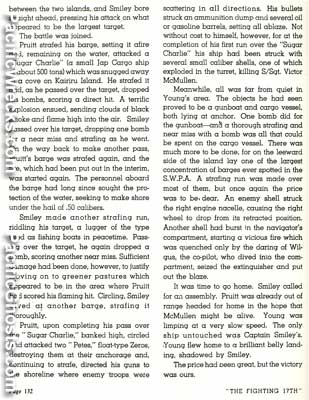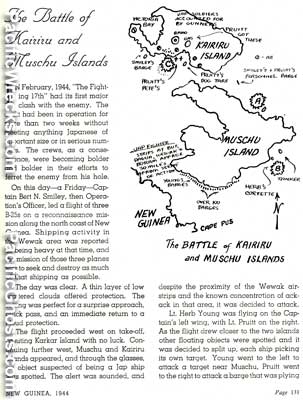February 6, 1944
(FEAF) A-20s hit shipping near Kairiru and Mushu Islands causing considerable damage
and destruction.
February (11, 18, 25 ?) 1944, Friday

 (FEAF) Three
B-25s, piloted by Captain Bert N. Smiley (Operations Officer), Lt. Herb Young
and Lt. Pruitt, all from the 17th TRG "Fight'in 17th" experience their first
significant combat on an armed reconnaissance mission. They flew over Kar Kar
Island, but found nothing. They proceeded to Wewak with clear
weather, and low scattered clouds. Spotting a ship off Muschu and
Kairiru Islands, they split up to attack a variety of targets. Prutt attacked
a barge setting it on fire, and a direct hit on a 'Sugar Charlie (500 ton
cargo vessel) in a cove on Kairiru. Smiley attacked a ship getting near misses
and a lugger, and strafing another barge, then strafed two PETE seaplanes
moored off Kairuru, and targets on land. Young bombed a gun boat, and
near missed a cargo vessel. On the south side of Muschu Island, a large concentration
of barges, reportedly the largest ever seen in SWPA was strafed. The costs
were Smiley's top turret gunner S/Sgt Victor McMullen, who was KIA. Young's
plane was damaged, a fire in navigator's compartment and causing the left
gear to drop out of the plane, and belly landed back at base. Reference:
17th TRG "Fight'in 17th" History "The Battle of Kairiru and Muschi Islands",
pages 131 - 132.
(FEAF) Three
B-25s, piloted by Captain Bert N. Smiley (Operations Officer), Lt. Herb Young
and Lt. Pruitt, all from the 17th TRG "Fight'in 17th" experience their first
significant combat on an armed reconnaissance mission. They flew over Kar Kar
Island, but found nothing. They proceeded to Wewak with clear
weather, and low scattered clouds. Spotting a ship off Muschu and
Kairiru Islands, they split up to attack a variety of targets. Prutt attacked
a barge setting it on fire, and a direct hit on a 'Sugar Charlie (500 ton
cargo vessel) in a cove on Kairiru. Smiley attacked a ship getting near misses
and a lugger, and strafing another barge, then strafed two PETE seaplanes
moored off Kairuru, and targets on land. Young bombed a gun boat, and
near missed a cargo vessel. On the south side of Muschu Island, a large concentration
of barges, reportedly the largest ever seen in SWPA was strafed. The costs
were Smiley's top turret gunner S/Sgt Victor McMullen, who was KIA. Young's
plane was damaged, a fire in navigator's compartment and causing the left
gear to drop out of the plane, and belly landed back at base. Reference:
17th TRG "Fight'in 17th" History "The Battle of Kairiru and Muschi Islands",
pages 131 - 132.
March 26, 1944
(FEAF) B-24s, B-25s, A-20s hit Mushu Island and other targets
April 10, 1944
(FEAF) B-24s and A-20s hit barges SE of Mushu Island and other targets.
April 27, 1944
(FEAF) B-24s, B-25s and A-20s attack Mushu and Kairiru Island
May 3, 1944
(FEAF) A-20s, B-25s and fighter-bombers, operating throughout the day hit Mushu Island
and other targets.
June 25, 1944
(FEAF, RAAF) Fifth Air Force and RAAF aircraft attack barges at Mushu and Kairiru Islands
June 26, 1944
(USN) PT-130 Lt. (jg) Ian Malcolm (USNR) and PT-132 (Ens Paul Jones (USNR)
investigted a target on the coast of Muschu, spotted by aircraft of RAAF 78 Squadron
based at Tadji. Both PT-Boats closed 75 yards of the shore, and found two barges
tied up behind camoflage netting with green foliage added, and soon discovered
more camoflaged 'nests'. The boats made four firing runs, setting many on fire,
and revealing 14 barges, 6 set on fire. Ricocettes from firing started grass
fires nearby and touched off a nearby ammo dump, sending smoke 100 feet high
and four other explosions. Low on ammo, they returned to their tender and the
next morning returned, covered by four P-39s, that finished destroying all targets. They
boats were sniped at from the island, and inarrate 40mm fire from Cape
Pus.
July 13, 1944
(FEAF) A-20s and fighter-bombers pound occupied areas and gun positions on Mushu Island. Lost is Beaufighter A19-185.
August 23, 1944
(FEAF) Fighter-bombers hit barge terminal on Mushu Island.
April 11, 1944
(Australian Army) Eight "Z" Special Unit (Z Force) commandos land on Muschu Island. Seven were killed and only Dennis escaped by swimming to coast.
August 1, 1945
(RAN) ML 805 and ML 809 approached Muschu broadcasting surrender messages, without result.
August 17, 1945
(RAN) Two days after Japan's surrender, two Japanese boats with white flags approached ML 805, and a meeting occurred on the beach of Muschu to arrange the surrender of Navy personal.
September 10, 1945
(RAN)
Rear-Admiral Sato boarded ML 805 in the Kairuru Strait and surrendered the remaining Japanese Navy forces under his command on Muschu and Kairuru by handed over his sword to Australian Army Major-General Robertson, commander of the 6th Division. Three days later, the Army
garrison surrendered at Cape Wom.
Contribute
Information
Do you have photos or additional information to add?

